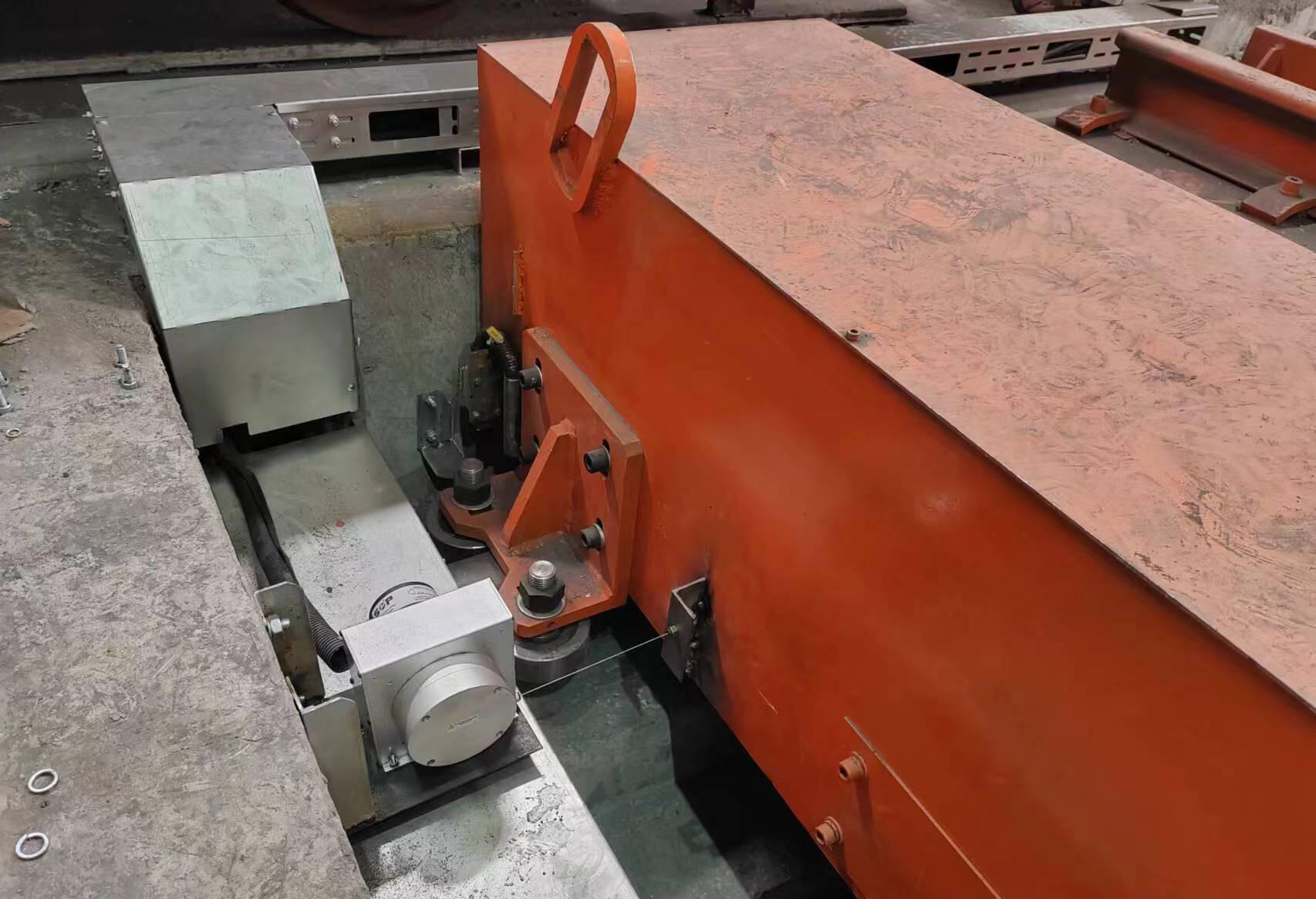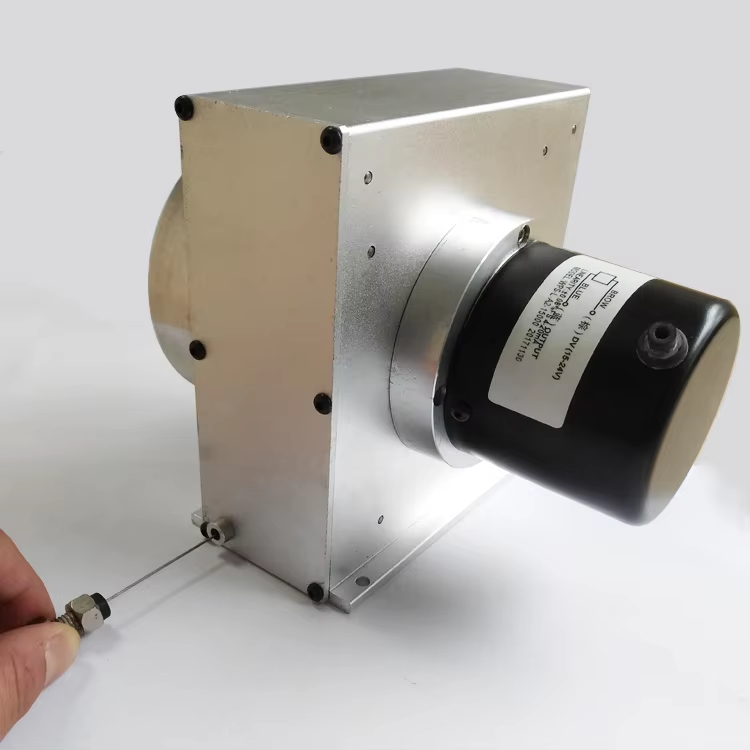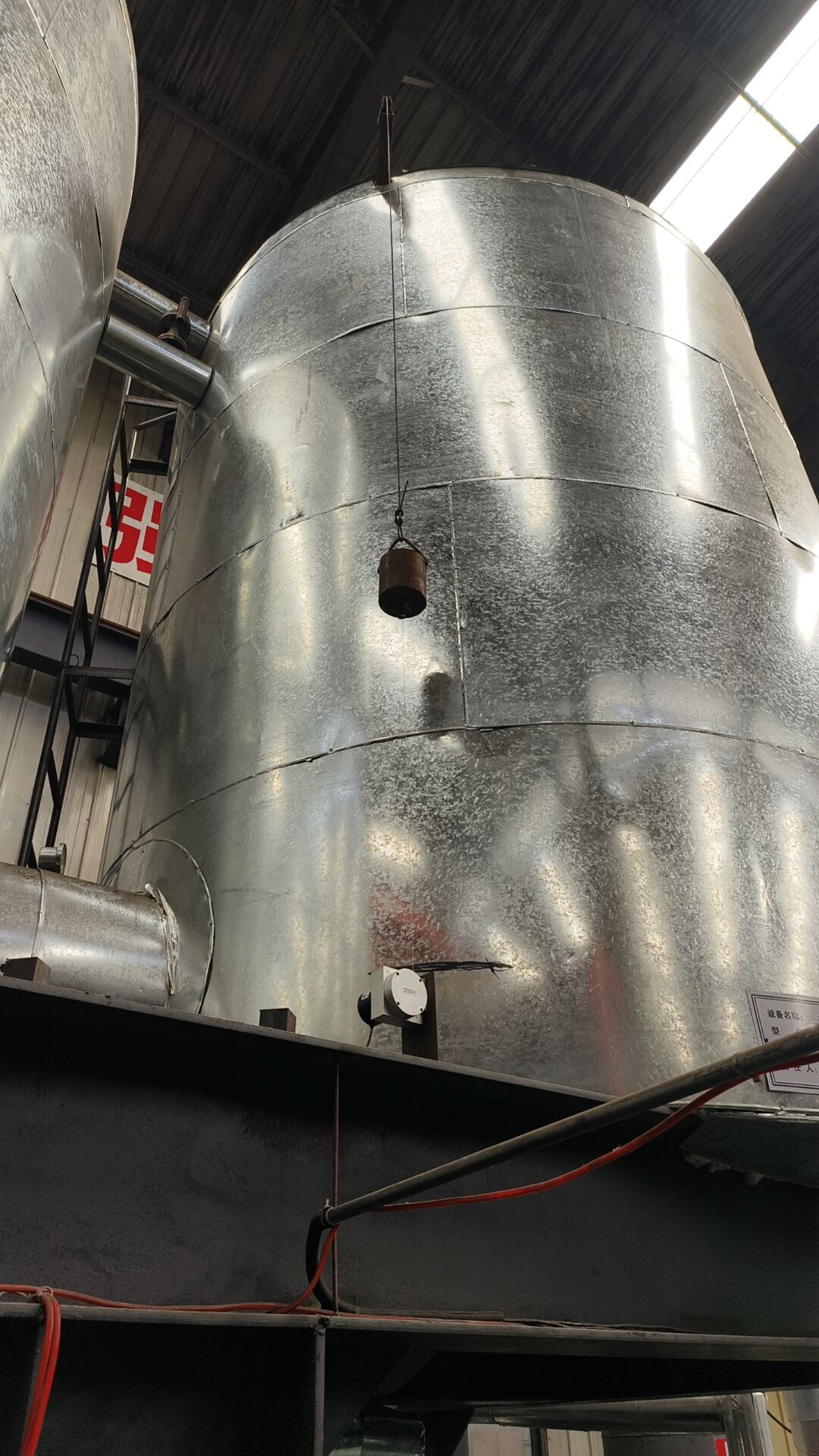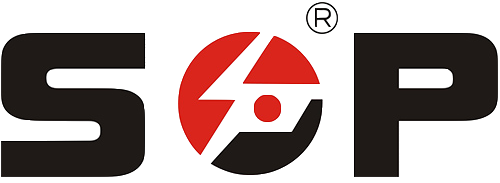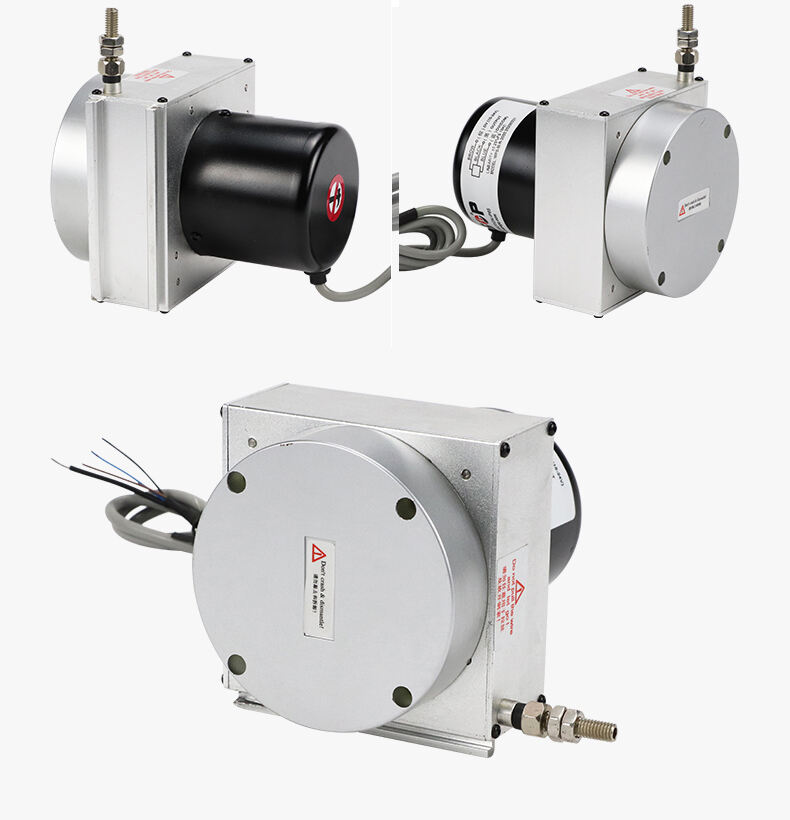เหตุใดจึงควรใช้เซ็นเซอร์สายลากสำหรับการวัดระยะทางไกล?
ในอุตสาหกรรมตั้งแต่การก่อสร้างไปจนถึงหุ่นยนต์ การวัดระยะทางให้ได้แม่นยำเป็นสิ่งสำคัญอย่างยิ่งต่อความปลอดภัย ประสิทธิภาพ และความละเอียดอ่อน ไม่ว่าจะเป็นการตรวจสอบตำแหน่งของกระบอกไฮดรอลิก การติดตามการยืดออกของกระบอกสูบ หรือการวัดการเคลื่อนที่ของสายพานลำเลียง เซ็นเซอร์แบบเดิมมักทำงานได้จำกัดเมื่อต้องวัดระยะทางเกิน 10 เมตร นี่จึงเป็นจุดที่ draw wire sensors -หรือที่เรียกกันว่าเซ็นเซอร์แบบใช้สายเคเบิล-โดดเด่น เป็นอุปกรณ์ที่ออกแบบมาเพื่อรองรับระยะทางที่ไกลอย่างเชื่อถือได้ มอบความแม่นยำ ความทนทาน และความยืดหยุ่นที่ผสมผสานกันอย่างลงตัว ทำให้เป็นสิ่งจำเป็นสำหรับงานวัดระยะทางไกล มาดูกันว่าทำไม draw wire sensors จึงเป็นตัวเลือกอันดับหนึ่งสำหรับการประยุกต์ใช้งานระยะทางไกล
หลักการทำงานของเซ็นเซอร์แบบสายลาก: การออกแบบที่เรียบง่ายแต่มีประสิทธิภาพ
หลักการทำงานของเซ็นเซอร์แบบสายลากนั้นพื้นฐานและเข้าใจได้ง่าย สายเคเบิลที่บางและแข็งแรง (โดยทั่วไปทำจากเหล็กกล้าไร้สนิมหรือพอลิเมอร์เสริมแรง) จะถูกพันรอบชุดกลองที่มีสปริงคอยดึงกลับ เมื่อวัตถุเคลื่อนที่ สายเคเบิลจะยืดออกหรือหดกลับ ทำให้ชุดกลองหมุน การหมุนนี้จะถูกแปลงเป็นสัญญาณไฟฟ้า (แบบแอนะล็อก ดิจิทัล หรือแบบอนุกรม) โดยตัวเข้ารหัส (Encoder) หรือโพเทนชิโอเมตร (Potentiometer) ที่อยู่ภายในเซ็นเซอร์ จากนั้นจึงแปลงเป็นค่าการวัดระยะทาง
การออกแบบเช่นนี้เหมาะสมโดยธรรมชาติสำหรับการวัดระยะทางไกล เมื่อเทียบกับเซ็นเซอร์เลเซอร์ที่อาจมีปัญหาจากสิ่งกีดขวางหรือสิ่งรบกวนจากสภาพแวดล้อม หรือเซ็นเซอร์อัลตราโซนิกที่ความแม่นยำลดลงเมื่อระยะทางไกลขึ้น เซ็นเซอร์แบบสายลากจะรักษาการสัมผัสกับวัตถุที่เคลื่อนที่ผ่านทางสายเคเบิลโดยตรง การเชื่อมต่อโดยตรงนี้ทำให้การวัดมีความน่าเชื่อถือแม้ระยะทางจะมากถึง 50 เมตรหรือมากกว่า จึงเหมาะสำหรับนำไปใช้งานตัวอย่างเช่น:
1. การตรวจสอบระดับความสูงของเครนเหนือศีรษะบนสะพาน (ซึ่งอาจมีระยะทาง 30–100 เมตร)
2. การวัดการยืดออกของแขนยืดไสลด์บนแพลตฟอร์มทำงานบนอากาศ
3. การตรวจจับตำแหน่งของประตูหรือทางเข้าในโรงงานอุตสาหกรรมที่มีช่องเปิดขนาดใหญ่
ความเรียบง่ายของดีไซน์ยังหมายถึงชิ้นส่วนที่น้อยลง ทำให้มีโอกาสเสียหายต่ำและเพิ่มความทนทานในสภาพแวดล้อมที่ยากลำบาก ซึ่งเป็นข้อได้เปรียบหลักสำหรับการใช้งานระยะไกลที่การเปลี่ยนเซ็นเซอร์มีค่าใช้จ่ายสูงหรือใช้เวลานาน
ความแม่นยำตลอดระยะทางที่ยาวนาน
หนึ่งในเหตุผลหลักในการเลือกใช้เซ็นเซอร์แบบสายลากสำหรับการวัดระยะทางไกลคือความเที่ยงตรงที่สม่ำเสมอ ต่างจากเทคโนโลยีบางชนิดที่ความแม่นยำลดลงเมื่อระยะทางเพิ่มขึ้น เซ็นเซอร์แบบสายลากสามารถรักษาระดับความแม่นยำที่แน่นอนแม้ระยะทางจะมากกว่า 100 เมตร
เซนเซอร์แบบสายล้อส่วนใหญ่มีค่าความผิดพลาดเชิงเส้นอยู่ที่ ±0.1% ถึง ±0.5% ของย่านการวัด เช่น เซนเซอร์ที่วัดระยะทางได้สูงสุด 50 เมตร จะมีความคลาดเคลื่อนอยู่ในช่วง 5–25 มิลลิเมตร จากระยะทางจริง ระดับความแม่นยำนี้เพียงพอสำหรับการใช้งานในอุตสาหกรรมส่วนใหญ่ ไม่ว่าจะเป็นการจัดแนวเครื่องจักรขนาดใหญ่ไปจนถึงการปรับตำแหน่งแผงโซลาร์เซลล์ให้มีประสิทธิภาพสูงสุด
ปัจจัยหลายประการมีผลต่อความแม่นยำนี้:
1,สายเคเบิลคุณภาพสูง: สายเคเบิลมีการยืดตัวต่ำ (น้อยกว่า 0.1% ภายใต้แรงดึง) ทำให้เกิดการเปลี่ยนแปลงของการวัดที่น้อยที่สุด แม้จะถูกดึงออกจนถึงความยาวสูงสุด ตัวอย่างเช่น สายเคเบิลสเตนเลสมีแรงดึงและความทรงตัวที่คงทนตลอดการใช้งานหลายพันครั้ง
2,เอนโคเดอร์ความละเอียดสูง: รุ่นขั้นสูงใช้เอนโคเดอร์แบบออปติคอลหรือแม่เหล็กที่มีความละเอียดสูง (สูงสุด 16 บิต) แปลงการหมุนของแกนล้อเป็นหน่วยระยะทางที่ละเอียดมาก โดยบางรุ่นสามารถตรวจจับการเคลื่อนไหวที่เล็กถึง 0.1 มิลลิเมตร แม้ในระยะทางมากถึง 100 เมตร
3, กลไกสปริงที่มีเสถียรภาพ: สปริงที่ดึงสายเคเบิลกลับได้รับการปรับเทียบให้รักษาระดับแรงตึงสม่ำเสมอ เพื่อป้องกันไม่ให้สายหย่อนซึ่งอาจก่อให้เกิดข้อผิดพลาด นี่เป็นสิ่งสำคัญสำหรับการใช้งานที่วัตถุเคลื่อนที่มีการเร่งความเร็วหรือลดความเร็ว เช่น ช่องทางเดินลิฟต์ หรือระบบลำเลียงวัสดุ
ในทางตรงกันข้าม เซ็นเซอร์เลเซอร์อาจประสบปัญหาการสะท้อนแสงเมื่อวัดระยะทางไกล ในขณะที่เซ็นเซอร์อัลตราโซนิกมักเกิดข้อผิดพลาดในสภาพแวดล้อมที่มีเสียงรบกวน ส่วนเซ็นเซอร์แบบ Draw Wire นั้นเนื่องจากมีการเชื่อมต่อทางกายภาพโดยตรง จึงหลีกเลี่ยงปัญหาเหล่านี้ได้
ความทนทานสำหรับสภาพแวดล้อมที่รุนแรง
การวัดระยะทางไกลมักเกิดขึ้นภายใต้สภาวะที่ท้าทาย เช่น บริเวณก่อสร้างที่มีฝุ่นและเศษซาก สถานที่ติดตั้งกลางแจ้งที่เผชิญกับฝนและการเปลี่ยนแปลงของอุณหภูมิอย่างรุนแรง หรือโรงงานอุตสาหกรรมที่มีการสั่นสะเทือนและสารเคมี เซ็นเซอร์แบบ Draw Wire ถูกออกแบบมาเพื่อทนต่อสภาพแวดล้อมเหล่านี้ ทำให้มีความน่าเชื่อถือมากกว่าทางเลือกที่บอบบางกว่า
คุณสมบัตุด้านความทนทานที่สำคัญรวมถึง:
1. ตู้ปิดสนิท: เซ็นเซอร์วัดระยะแบบสายลาก (Draw Wire Sensors) ระดับอุตสาหกรรมส่วนใหญ่มีค่าการป้องกัน IP65, IP67 หรือแม้แต่ IP68 ซึ่งช่วยปกป้องชิ้นส่วนภายในจากน้ำ ฝุ่น และสิ่งสกปรก สิ่งนี้มีความสำคัญอย่างยิ่งสำหรับการใช้งานกลางแจ้ง เช่น การตรวจสอบระดับน้ำท่วม หรือการติดตามตำแหน่งของเครนในเรือ
2. สายเคเบิลทนการขัดถู: สายเคเบิลมีการเคลือบด้วยวัสดุเช่น เทฟลอน (Teflon) หรือโพลียูรีเทน (Polyurethane) เพื่อต้านทานการสึกหรอจากแรงเสียดทาน ทำให้มั่นใจได้ว่าจะคงสภาพสมบูรณ์แม้ผ่านการใช้งานมากกว่า 1 ล้านครั้งในการดึงออกและเก็บกลับ
3. ทนต่อการสั่นสะเทือนและแรงกระแทก: เซ็นเซอร์ได้รับการทดสอบเพื่อให้สามารถทนต่อการสั่นสะเทือนได้ถึง 100 เฮิรตซ์ (Hz) และแรงกระแทกได้ถึง 1000 G จึงเหมาะสำหรับนำไปใช้ในเครื่องจักรหนักหรือการขนส่ง (เช่น การวัดตำแหน่งของรถพ่วงบรรทุกสินค้าขณะโหลดของ)
4. ช่วงอุณหภูมิการทำงานกว้าง: อุณหภูมิในการทำงานตั้งแต่ -40°C ถึง 85°C ทำให้เซ็นเซอร์วัดระยะแบบสายลากสามารถทำงานได้ทั้งในสภาพอากาศขั้วโลก เขตทะเลทราย หรือเตาอบอุตสาหกรรม
ตัวอย่างเช่น ในโรงงานถลุงเหล็กที่อุณหภูมิสูงกว่า 60°C และมีฝุ่นตลอดเวลา เซ็นเซอร์แบบสายล้อสามารถวัดตำแหน่งของเครื่องอัดไฮดรอลิกในโรงกลิ้งได้อย่างเชื่อถือได้ ในขณะที่เซ็นเซอร์เลเซอร์อาจเกิดความล้มเหลวเนื่องจากความร้อนทำให้เกิดการบิดเบือนหรือฝุ่นบังลำแสง
ความยืดหยุ่นและการติดตั้งง่าย
สถานการณ์การวัดระยะทางไกล มักไม่ใช่เส้นทางตรงที่ปราศจากสิ่งกีดขวาง นั่นจึงเป็นเหตุผลว่าทำไมความยืดหยุ่นของเซ็นเซอร์แบบสายล้อจึงเป็นข้อได้เปรียบหลัก เมื่อเทียบกับเซ็นเซอร์แบบติดตั้งคงที่ (เช่น เลเซอร์ หรือเรดาร์) เซ็นเซอร์แบบสายล้อสามารถติดตั้งในพื้นที่ที่ไม่เหมาะสม เช่น รอบๆ มุม เหนือชิ้นส่วนที่เคลื่อนที่ หรือในพื้นที่แคบ โดยไม่ส่งผลต่อประสิทธิภาพการทำงาน
การติดตั้งง่ายดาย:
1. ติดตั้งเซ็นเซอร์เข้ากับโครงสร้างที่แน่นหนึ่ง (เช่น ผนังหรือกรอบ)
2. ติดปลายสายเคเบิลเข้ากับวัตถุที่เคลื่อนที่ (โดยใช้ตะขอ ราวแขวน หรือแม่เหล็ก)
3. ปรับเทียบเซ็นเซอร์ให้อยู่ในช่วงที่ต้องการ โดยใช้ซอฟต์แวร์ง่ายๆ หรือหมุนปรับโพเทนชิโอเมตร
ความเรียบง่ายนี้ช่วยลดเวลาในการติดตั้งเมื่อเทียบกับระบบเลเซอร์ที่ต้องการการจัดแนวอย่างระมัดระวัง หรือเซ็นเซอร์อัลตราโซนิกที่ต้องการเส้นทางมองเห็นที่ชัดเจน ตัวอย่างเช่น การติดตั้งเซ็นเซอร์แบบสายลากเพื่อวัดระยะยื่นของแขนเครนแบบโทรสโคปิกยาว 50 เมตร ใช้เวลาน้อยกว่าหนึ่งชั่วโมง ในขณะที่การปรับแนวเซ็นเซอร์เลเซอร์สำหรับงานเดียวกันอาจใช้เวลานานถึงครึ่งวัน
เซ็นเซอร์แบบสายลากยังสามารถปรับตัวได้ดีกับการเคลื่อนที่ที่ไม่สม่ำเสมอ หากวัตถุที่เคลื่อนที่มีการเปลี่ยนแปลงตำแหน่งในแนวนอนหรือแนวตั้งเพียงเล็กน้อย ความยืดหยุ่นของสายเคเบิลจะช่วยให้มันตามการเคลื่อนที่ได้โดยไม่เกิดข้อผิดพลาด ซึ่งเป็นประโยชน์อย่างมากในงานประยุกต์เช่น แขนกลหุ่นยนต์ที่เคลื่อนไหวได้หลายแกน
คุ้มค่าเมื่อใช้งานระยะทางไกล
สำหรับระยะทางเกิน 10 เมตร เซ็นเซอร์แบบสายลากมักมีราคาประหยัดกว่าทางเลือกอื่นๆ เซ็นเซอร์เลเซอร์ที่สามารถวัดระยะทางได้ 100 เมตร มีราคาสูงกว่าเซ็นเซอร์แบบสายลากที่เทียบเท่ากันถึง 2–3 เท่า โดยไม่ได้ให้ความแม่นยำที่ดีกว่าอย่างมีนัยสำคัญในสภาพแวดล้อมอุตสาหกรรม
การประหยัดต้นทุนนี้ยังรวมถึงค่าบำรุงรักษา อุปกรณ์เซ็นเซอร์แบบสายลากมีชิ้นส่วนที่บอบบางน้อยกว่าระบบเลเซอร์หรือระบบแสง จึงช่วยลดค่าใช้จ่ายในการซ่อมแซม สายเคเบิลซึ่งเป็นส่วนที่สึกหรอได้ง่ายสามารถเปลี่ยนได้ในราคาประหยัด (โดยทั่วไปอยู่ที่ประมาณ
50– 200 บาท) และแบบจำลองจำนวนมากสามารถเปลี่ยนสายเคเบิลเองได้ทันทีในสถานที่โดยไม่ต้องใช้อุปกรณ์พิเศษแต่อย่างใด
สำหรับการใช้งานในปริมาณมาก เช่น การติดตั้งอุปกรณ์เซ็นเซอร์บนสายพานลำเลียง 100 เส้นขึ้นไปภายในศูนย์โลจิสติกส์ ต้นทุนการซื้อและบำรุงรักษาอุปกรณ์เซ็นเซอร์แบบสายลากที่ต่ำกว่าสามารถช่วยประหยัดเงินได้หลายหมื่นดอลลาร์
คำถามที่พบบ่อย: อุปกรณ์เซ็นเซอร์แบบสายลากสำหรับการวัดระยะทางไกล
อุปกรณ์เซ็นเซอร์แบบสายลากสามารถวัดระยะทางได้ไกลที่สุดเท่าไร
แบบจำลองทางการค้ามีให้เลือกสำหรับระยะทางตั้งแต่ 1 เมตร ไปจนถึง 500 เมตร และยังมีทางเลือกที่ออกแบบมาเฉพาะสำหรับระยะทางที่ไกลกว่านี้ ข้อจำกัดที่สามารถใช้งานได้จริงขึ้นอยู่กับความแข็งแรงของสายเคเบิล สายเคเบิลที่ยาวขึ้นจะต้องใช้วัสดุที่หนาและแข็งแรงมากขึ้นเพื่อหลีกเลี่ยงปัญหาสายหย่อน
อุปกรณ์เซ็นเซอร์แบบสายลากสามารถวัดการเคลื่อนที่แบบไม่เป็นเส้นตรงได้หรือไม่
ใช่ แต่มีข้อจำกัดบางประการ แม้ว่าเซ็นเซอร์จะวัดระยะทางแบบเส้นตรง แต่สายเคเบิลสามารถตามการเคลื่อนที่ในแนวข้างเล็กน้อยได้ (ไม่เกิน ±10° จากแกนของเซ็นเซอร์) โดยที่ความผิดพลาดยังคงอยู่ในระดับต่ำ สำหรับเส้นทางที่มีลักษณะไม่เป็นเชิงเส้นสูง สามารถใช้เซ็นเซอร์หลายตัวร่วมกันเพื่อติดตามการเคลื่อนที่ในสองหรือสามมิติ
เซ็นเซอร์แบบสายลากต้องทำการปรับเทียบบ่อยแค่ไหน?
ส่วนใหญ่แล้ว เซ็นเซอร์จะต้องการการปรับเทียบเพียงครั้งเดียวในระหว่างการติดตั้ง หากระบบประกอบมีความเสถียร ค่าคลาดเคลื่อน (drift) จะมีขนาดเล็กมาก โดยปกติน้อยกว่า 0.1% ต่อปี สภาพแวดล้อมที่มีอุณหภูมิเปลี่ยนแปลงอย่างรุนแรงหรือสั่นสะเทือนหนัก อาจจำเป็นต้องทำการปรับเทียบใหม่ทุกปี
เซ็นเซอร์แบบสายลากเหมาะกับงานที่มีความเร็วสูงหรือไม่?
ใช่ เซ็นเซอร์สามารถใช้งานได้ แต่เวลาตอบสนองขึ้นอยู่กับตัวเอนโค้ดเดอร์ โดยเอนโค้ดเดอร์แบบแสงสามารถรองรับความเร็วได้สูงสุดถึง 5 เมตร/วินาที ซึ่งเหมาะสมกับวัตถุที่เคลื่อนที่เร็ว เช่น ลิฟต์โดยสารหรือสายพานลำเลียงความเร็วสูง สำหรับการใช้งานที่ต้องการความเร็วสูงกว่านี้ (เช่น 10 เมตร/วินาทีขึ้นไป) มีรุ่นพิเศษสำหรับงานความเร็วสูงให้เลือกใช้งาน
หากสายเคเบิลขาดจะเกิดอะไรขึ้น?
เซ็นเซอร์แบบสายล้อหลายชนิดมีคุณสมบัตุในการตรวจจับสายเคเบิลขาด ซึ่งจะทำให้ระบบสัญญาณเตือนทำงานหรือปิดระบบเพื่อป้องกันการใช้งานที่ไม่ปลอดภัย บางรุ่นยังมีคุณสมบัตุในการรีเซ็ตสายเคเบิลด้วยตนเองเพื่อให้เปลี่ยนสายเคเบิลได้ง่ายขึ้น การใช้เซ็นเซอร์ที่มีสายเคเบิลสำรอง (มีให้เลือกในรุ่นอุตสาหกรรม) จะช่วยเพิ่มความปลอดภัยอีกระดับ

